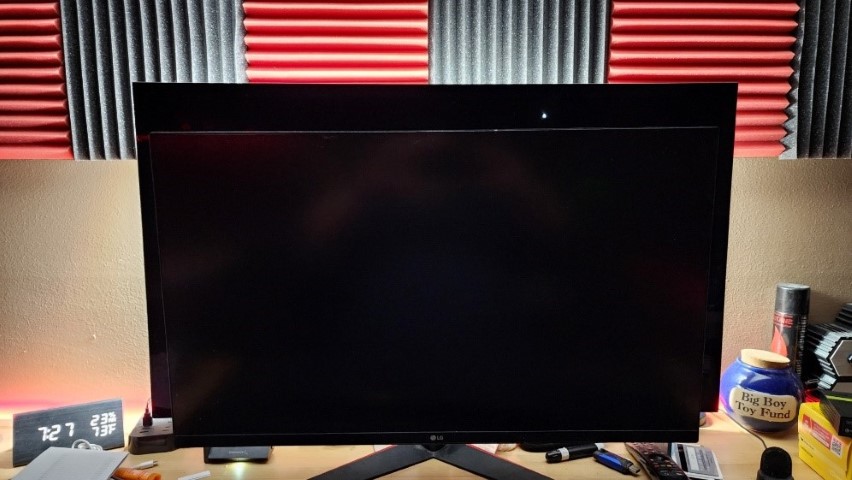
I have been given an opportunity to play with an LG C2 42” OLED and so thought this would be a perfect time to discuss my experience.
First where I am starting from, my daily driver was an LG 32” 1440P display. Had good color and at 144hz with a fast VA panel it was a great gaming experience. The screen is big enough that 1440P does or doesn’t??? cause me to squint. The game experience is outstanding, and I have been quite happy with this display.
The C2 brings a few things to the table besides OLED. At 42” it is a larger display and does this at 4K. While the refresh rate is lower at 120hz vs 144hz, for my gaming style this is not a big deal. I play solo or coop games with a lot of RGPs. There is also of course the fact the resolution jumps to 4K.
I could spend quite a bit of time talking about 4K vs 1440P and the advantages and disadvantages of a larger display. However, I want to focus on OLED and what it is bringing to the table, especially when compared to a good VA screen for gaming or even an IPS.
First let’s begin with the suspects in our investigation. We have for the OLED a LG C2 42” TV for the VA Panel we have an AOC 32” VA that is rated for HDR 400. For IPS we have an LG 27GL850 27'' Ultra Gear. Two of these displays are 1440 and the C2 is 4K. While there will be image quality differences due to pixel density and resolution, I am focusing on how the color and contrast look from the perspective of a PC Gamer. I have a few other monitors in the mix but they are older.
Next, I will not be looking at HDR. Wait a minute, why would you have an OLED and not use HDR, you might be asking. Well, the reason for this is twofold. First if HDR is done right the OLED will destroy the other two displays and we all know it. Second, 95% or better of games do not make use of HDR and game only in SDR. So, we are looking to see if the OLED can really blow away the competition in typical daily gaming use.
For testing purposes, I will test in two rooms. The first is my office, the only outside window has solid blinds over it so no real external light. The lights in the room are indirect and sit behind the display. This gives the room a very twilight feels to the lighting. The second room is my family room. It has a large patio door and the living room next to it a large picture window, so lights of natural lighting. All testing for the family room is run during the day the office setup can be run any time as the lighting in it is much more controlled.
This testing is 100% subjective, so I am just giving my impressions and some quick comments made by friends and family. You will notice there are no images and screenshots, that is because unless you have the specific display, screen shots will not really show what I am seeing and even a camera is just not up to task, I did try.
Before we dive into the image quality lets discuss the “elephant” in the room. A 42” display is BIG. The C2 is a massive 927mm across while a flat 32” display (which many think is big) is 711mm. Vertically the C2 is 534mm while the 32” display is 426mm. This means you need a large desk to make use of the 42” display. I would suggest a minimum desk depth of 762mm (30”). I have tried it with a 24” depth table and the screen is just to close. It can work but it feels uncomfortable. I have seen people talking about using 48” displays on 30” depth desks but to me that would be too large.
The large size might seem like a downside but it really has some nice advantages. It allows for an immersive experience as the screen fills your field of vision. It also means the 4K resolution does not need a ton of scaling to be legible for those of us with less than perfect eye sight.
However, I am here to talk about the OLED panel so lets not do a deep dive into the TV and Monitor debate.
When first using the OLED with no tweaking, all I can say is WOW. When you compare the OLED out of the box experience to the same for the IPS and VA panel (factory defaults), the OLED color pop is so amazing if defies description. However, is also has some things I did not like. Like the other 2 displays it was overly bright for the office space. The deep contrast made whites on a dark background eye searing. It was also very much to the cool end of the color range; everything felt a little blue in color.
A few adjustments later and I had the display zoned into what I enjoy. Again, compared to calibrated versions of the other two displays the differences where noticeable, especially the deep blacks and the color pop due to the contrast.
For gaming comparisons, I chose to use EVE, Far Cry New Dawn, World of Tanks and Elder Scrolls Online. This might not seem like a good mix, but I did this for a reason. As I stated I know that in HDR mode the OLED will destroy the others. However, most games are not HDR and these games all represent SDR color, some more colorful than others but all have some solid SDR style detailing. I wanted to see how they compared.
EVE is an old game but has consistently over the years been one of the best-looking space games on the market. The ships have a lot of details, moving parts and space is fillover nebulas and stars with planets, moons and asteroids. I chose a mining barge do a deep dive. The ship has a lot of detail with moving parts and special effects all over it.
The space around the ship has very noticeable differences and not always in the way you would expect. The colors within the nebula have a real pop to them on the OLED. They look good on the VA, the IPS does a good job the black areas feel a bit washed.
When you zoom in on the ship however the real differences come to light. The shadows on the VA panel seem to overextend, areas that are dark are VERY dark and lose detail. The same areas on the OLED are dark but the detail is still very visible and clear. The mining lasers glow is intense and the little flame areas around the ship have a sharp appearance when they flair. The extra contrast and individual lighting zones allow for the detail to stay very intact.
Far Cry New Dawn is a game full of color, vibrant and alive. This game made me convert from an IPS display to a VA, the color pop just makes this game stand out and look incredible. Again the contrast of the OLED came into play quickly, the color pop on the OLED was noticeably more vibrant than even on the VA. Do not get me wrong the VA panel looked incredible but then take everything up a notch and that was the OLED experience.
Elder Scrolls Online is a solid looking, middle of the road game, good graphics and nice color. The difference however to me was the detail. I could see details in my character’s armor that were always washed out before. Now that fine detail was clear and crisp. This was also the first game where I found a flaw with the OLED. The game has some dark dungeons and I presumed like the other games the contrast would allow the detail to just stand out. Instead, the dark dungeons crushed the back, making the entire scene look muddled. I am sure this is a texture and color palette choice from the game design but the effect is there none the less. Games of that era where not designed with this kind of color contrast being possible and it showed.
World of Tanks took me back to a great overall experience with again the contrast allowing the highly detailed models to stand out. It also however showed that some of the older models need some updating as that enhanced detail was showing the old design flaws. This was not as noticeable an effect as what I saw in ESO but it was there if you looked closely.
Using these games as a base mark and others not mentioned, OLED shows that while HDR might be its claim to fame, in SDR mode this display is incredible. The Gaming experience takes on a whole new vibrance that lives up to the hype. However, as I noted, not all games will enjoy the same effects, even in SDR mode.
What happens when you leave the world of gaming? Well I use the display for web browsing, office work and content viewing. On the whole my experience has been positive. Yes, you notice correctly, my gushing has diminished. For typical office work an OLED is good no doubt. However, I am not sure it is massively better than a good VA or IPS display. The reasoning for this is in part from the built in safe guards of an OLED panel.
OLED panels have a potential downside, the individual pixels will wear out over use. This is not as big of a deal as it sounds but this does mean depending on the use you will unevenly wear the pixels. This can lead to the effect referred to as burn in, though that term is not accurate.
To counter this, OLED displays have a number of safety features, one in particular is ABL, Automatic Brightness limiter. This feature will dim the display based on various variables. The effect is to have a word document, for example dim as your typing and then suddenly brighten again as some variable changes. (This latterly just happened while I am typing.) This can be a bit frustrating when you’re working. The VA and IPS displays do not suffer from this so they feel “brighter” when doing office work.
Speaking of brightness, the OLED did okay in the fully light room. However, it’s advantages diminished a bit. The slightly brighter active ability of the VA and IPS meant that while they did not over take the OLED for display they did gain ground. Also, the OLED (in the case of the display I am using) uses a glossy panel which meant the brighter room had some reflection issues, where the other panels had matt finishes that mitigated this quite a bit.
So the question I asked in the title is if OLED is ready for gamers now. My answer, despite the gushing is, NO. Do not get me wrong OLED is amazing and if you want one and can afford it then I will not discourage you. However, some reality has to set in with this consideration.
OLED is expensive, you will spend at least $1000 for any OLED display. This is a huge portion of a PC Gamers budget and with the current economic trends this is even more impactful. Also OLED right now is only available on higher resolution displays (3440x1440 is the lowest resolution on a full size display). This means you need a beefier system to really get the most out of the display, adding to the cost.
Software is not able to fully utilize OLED yet. OLED looks amazing with SDR and I love gaming on it. However, the real appeal of OLED is still the HDR potential and with PC Gaming that potential has not yet been realized significantly enough to justify the cost. A few more games down the road we may see better HDR implementations becoming the norm but by then OLED pricing will be reduced.
Some concerns also still exist with longevity with OLED. People like Barnacules, Windell at LevelOneTech and even Linus have noticed image retention issues (burn in) from extended use. This is getting better and with each new generation will continue to get better but when you pay a grand for a display the thought that it might begin to see an issue within 3 years is a tough pill to swallow.
When I look at all of this and take my experience into account I have to ask, if my brother wanted a new gaming rig tomorrow would I push him to buy an OLED and my answer is no. A good VA panel can come in for under HALF the price and give an amazing gaming experience. You can allow get it in a smaller size and resolution, giving you more options for your build budget.
It is easy for me to enjoy my OLED now that it is here. It is easy for people to get caught in the hype by the “pundits” that have pushed OLED as the holy grail of displays. However at some point we have to step back and look at the reality.
OLED might very well be the future of display technology, it offers amazing image quality and a contrast that is scared deep. However, at this time with the cost and still potential for issues over longevity and the lack of deep support for its best features, I feel more comfortable suggesting gamers save their money and stay with VA or IPS for the time being.
The articles content, opinions, beliefs and viewpoints expressed in SAPPHIRE NATION are the authors’ own and do not necessarily represent official policy or position of SAPPHIRE Technology.




















